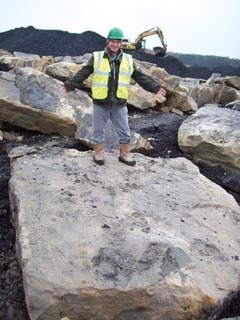Three new stone sources come on-stream
Stone specialist Realstone has reached an agreement with the Banks Group, whose activities include opencast coal mining, to take blocks of sandstone that are removed in order to reach the coal.
At the same time, Drumhead Quarry in Denny, Stirlingshire, is being re-opened by the landowners and Ham & Doulting Stone has gained planning permission to re-open Park Lane underground quarry, one of the largest of the Bath Stone mines.
Blagdon Buff
The Realstone arrangement comes on the heels of the suggestion by consultant Maurice Rogers that, as the HS2 rail route passes through areas where dimensional stone deposits are known to exist, blocks could be extracted as the route is constructed (see NSS January issue).
It remains to be seen whether that will be feasible, but it has opened a conversation on the idea more generally of using civil engineering work as a source of stone blocks.
Anthony McAdam, who now works for Realstone’s quarrying company, Block Stone, saw the potential of recovering blocks exposed by coal mining when he visited the 400m long Northumberlandia sculpture landscape of a woman being created by Charles Jencks. It is on the Blagdon Estate in Northumberland and is being created using material extracted from the opencast coal mining activity on the estate.
Anthony, who has spent all his life in the stone industry, saw hefty blocks of sandstone being removed to provide access to the coal seams.
Now Block Stone has come to an agreement with the miners, Banks, to take blocks of the Blagdon Buff sandstone that can be as much as 10m long and weigh 50tonnes.
Coal mining works on a different scale to normal dimensional stone production and, says Anthony: “We can get a thousand tonnes by the morning tea break.”
Banks are extracting the blocks and putting them aside for Block Stone. Anthony says there is already 20 years supply of top quality, large size block in stock at the site.
It is being sold as top quality building stone for £65/tonne and as walling for £35/tonne.
Now the Blagdon stone has been specified for a sculptural element outside the new Olympic Stadium, with Realstone processing and supplying the finished stone for it.
And the Blagdon Stone might be only the beginning of Block Stone’s association with Banks. The miners are working other sites that Anthony believes could yield other stones. He is currently exploring a site in Scotland that he believes could produce blocks of Binghy stone, one of Scotland’s traditional stones.
Cowie Rock
Another of Scotland’s stones, a blond sandstone known as Cowie Rock, is coming back into production as a result of Drumhead Quarry being
re-opened by the landowners, Davy and Tish Graham, who bought the farm the quarry is on in 1985.
What aroused their interest in the stone was a report by the British Geological Survey (BGS) in Edinburgh. The BGS had received an enquiry from Campdown in Australia for Scottish stone to match the original of a sculpture the town has of Robert Burns – said to be the oldest sculpture of the poet in the World.
It had been carved for the Great Exhibition of 1851 in Crystal Palace, London. It was bought by a man who took it with him when he emigrated to Australia. The Grahams have supplied the stone for the restoration of the statue and that, along with the report produced by the BGS in Scotland, prompted them to seek planning permission to start extracting the stone again.
They believe the stone will be in demand for repairs to a lot of buildings in Scotland that would otherwise have used stone imported from England.
The old quarry was used as a landfill site in the 1940s, but exploratory drilling identified remaining reserves of the stone that can be accessed. Last year the Graham’s applied for planning permission to extract the stone. One year and bat and badger surveys later and planning permission has been obtained.
Bath stone
It has taken Ham & Doulting Stone four times as long to obtain planning permission to resume extraction of Bath limestone from the Park Lane underground quarry. The planning authority finally authorised the application this month (on 11 April).
The underground quarry is below Neston Park in Somerset, the estate owned by the Fuller brewery family where the TV programme ‘Lark Rise to Candleford’ was recorded.
There were more than 40 letters of objection to the application from residents expressing their concern about lorries going through Neston village.
Ham & Doulting Director Zak England told NSS he would like it to be a problem but he doubted demand for the stone would require more than one lorry a day to visit the quarry.
Ham & Doulting have permission to build a new access road to the east of the village to overcome the objections.

